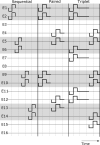Assessing the relationship between neural health measures and speech performance with simultaneous electric stimulation in cochlear implant listeners
- PMID: 34898654
- PMCID: PMC8668108
- DOI: 10.1371/journal.pone.0261295
Assessing the relationship between neural health measures and speech performance with simultaneous electric stimulation in cochlear implant listeners
Abstract
Objectives: The relationship between electrode-nerve interface (ENI) estimates and inter-subject differences in speech performance with sequential and simultaneous channel stimulation in adult cochlear implant listeners were explored. We investigated the hypothesis that individuals with good ENIs would perform better with simultaneous compared to sequential channel stimulation speech processing strategies than those estimated to have poor ENIs.
Methods: Fourteen postlingually deaf implanted cochlear implant users participated in the study. Speech understanding was assessed with a sentence test at signal-to-noise ratios that resulted in 50% performance for each user with the baseline strategy F120 Sequential. Two simultaneous stimulation strategies with either two (Paired) or three sets of virtual channels (Triplet) were tested at the same signal-to-noise ratio. ENI measures were estimated through: (I) voltage spread with electrical field imaging, (II) behavioral detection thresholds with focused stimulation, and (III) slope (IPG slope effect) and 50%-point differences (dB offset effect) of amplitude growth functions from electrically evoked compound action potentials with two interphase gaps.
Results: A significant effect of strategy on speech understanding performance was found, with Triplets showing a trend towards worse speech understanding performance than sequential stimulation. Focused thresholds correlated positively with the difference required to reach most comfortable level (MCL) between Sequential and Triplet strategies, an indirect measure of channel interaction. A significant offset effect (difference in dB between 50%-point for higher eCAP growth function slopes with two IPGs) was observed. No significant correlation was observed between the slopes for the two IPGs tested. None of the measures used in this study correlated with the differences in speech understanding scores between strategies.
Conclusions: The ENI measure based on behavioral focused thresholds could explain some of the difference in MCLs, but none of the ENI measures could explain the decrease in speech understanding with increasing pairs of simultaneously stimulated electrodes in processing strategies.
Conflict of interest statement
The authors have declared that no competing interests exist.
Figures





Similar articles
-
The Relationship Between Cochlear Implant Speech Perception Outcomes and Electrophysiological Measures of the Electrically Evoked Compound Action Potential.Ear Hear. 2023 Nov-Dec 01;44(6):1485-1497. doi: 10.1097/AUD.0000000000001389. Epub 2023 May 17. Ear Hear. 2023. PMID: 37194125 Free PMC article.
-
The Effect of Advanced Age on the Electrode-Neuron Interface in Cochlear Implant Users.Ear Hear. 2022 Jul-Aug 01;43(4):1300-1315. doi: 10.1097/AUD.0000000000001185. Epub 2021 Dec 21. Ear Hear. 2022. PMID: 34935648 Free PMC article.
-
Identifying Cochlear Implant Channels With Relatively Poor Electrode-Neuron Interfaces Using the Electrically Evoked Compound Action Potential.Ear Hear. 2020 Jul/Aug;41(4):961-973. doi: 10.1097/AUD.0000000000000844. Ear Hear. 2020. PMID: 31972772 Free PMC article.
-
The Effect of Interphase Gap on Neural Response of the Electrically Stimulated Cochlear Nerve in Children With Cochlear Nerve Deficiency and Children With Normal-Sized Cochlear Nerves.Ear Hear. 2020 Jul/Aug;41(4):918-934. doi: 10.1097/AUD.0000000000000815. Ear Hear. 2020. PMID: 31688319 Free PMC article.
-
Peripheral Neural Synchrony in Postlingually Deafened Adult Cochlear Implant Users.Ear Hear. 2024 Sep-Oct 01;45(5):1125-1137. doi: 10.1097/AUD.0000000000001502. Epub 2024 Mar 20. Ear Hear. 2024. PMID: 38503720 Free PMC article.
Cited by
-
Comparison of Performance for Cochlear-Implant Listeners Using Audio Processing Strategies Based on Short-Time Fast Fourier Transform or Spectral Feature Extraction.Ear Hear. 2025 Jan-Feb 01;46(1):163-183. doi: 10.1097/AUD.0000000000001565. Epub 2024 Sep 6. Ear Hear. 2025. PMID: 39680489 Free PMC article.
-
PET imaging of tissue reactions in the implanted cochlea: results of a pilot study.Front Immunol. 2025 Jul 10;16:1601742. doi: 10.3389/fimmu.2025.1601742. eCollection 2025. Front Immunol. 2025. PMID: 40709194 Free PMC article.
-
The Inter-Phase Gap Offset Effect as a Measure of Neural Health in Cochlear Implant Users With Residual Acoustic Hearing.Ear Hear. 2025 Jan-Feb 01;46(1):83-97. doi: 10.1097/AUD.0000000000001556. Epub 2024 Jul 26. Ear Hear. 2025. PMID: 39054580 Free PMC article.
-
An Electrically Evoked Compound Action Potential Marker for Local Spiral Ganglion Neuron Degeneration: The Failure Index.J Neurosci. 2025 Feb 12;45(7):e0954242024. doi: 10.1523/JNEUROSCI.0954-24.2024. J Neurosci. 2025. PMID: 39663117 Free PMC article.
-
A computational model to simulate spectral modulation and speech perception experiments of cochlear implant users.Front Neuroinform. 2023 Mar 9;17:934472. doi: 10.3389/fninf.2023.934472. eCollection 2023. Front Neuroinform. 2023. PMID: 37006637 Free PMC article.
References
Publication types
MeSH terms
LinkOut - more resources
Full Text Sources
Miscellaneous

